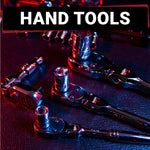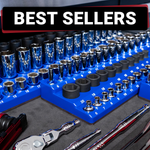- Home /
- All Products /
- 3-Pound Dead Blow Hammer With Polyurethane Head
3-Pound Dead Blow Hammer With Polyurethane Head
- Home /
- All Products /
- 3-Pound Dead Blow Hammer With Polyurethane Head
3-Pound Dead Blow Hammer With Polyurethane Head
- Steel Shot Filled Head Prevents Rebound
- Polyurethane Head is Resistant to Cuts & Abrasions
Polyurethane
Head
Our 3lb Dead Blow Hammer features a polyurethane head that is resistant to cuts and abrasions, ensuring it will last for years of heavy use.
No Rebound,
No Problem
The steel shot filled head of our Dead Blow Hammer prevents rebound, providing maximum impact with every strike.
Get a Grip
With a nonslip handle, our Dead Blow Hammer offers excellent control and reduces the risk of accidents during use.
Hold on
Tight
The knurled handle of our Dead Blow Hammer improves grip, giving you confidence and precision with each swing.
Protect Your
Surfaces
The polyurethane head of our Dead Blow Hammer ensures that it will never leave scratches or marks on the surfaces you're working on.
Why Buy From Us
Unrivaled Service
Talk to a real human for customer support within 30 business minutes or get your money back.
Limited Lifetime Warranty
All hand tools and tool organizers include a limited lifetime warranty that covers all manufacturer's defects.
90-Day Returns
Use our tools completely risk-free for 90 days and if you're not happy with them, get a full refund.
Satisfaction Guaranteed
We go above and beyond to to make your buying experience as easy & smooth as possible.
Package Contents
- 3 lb dead blow hammer
Specifications
- Dead Blow Hammer Material: Polyurethane head, rubber handle
- Weight: 3 lb
- Handle Texture: Knurled
- Country of Origin: Taiwan
3-Pound Dead Blow Hammer Features
Our 3-pound dead blow hammer delivers powerful, precise strikes without damaging delicate surfaces. Built for tough jobs, this hammer blends power, precision, and durability. The product details of our dead blow hammer include:
- Polyurethane head: Durable and resistant to cuts, the polyurethane head minimizes surface damage and provides solid impact.
- Shot-filled: The steel shot-filled hammer head prevents rebounds, so you get controlled and accurate strikes every time.
- Knurled handle: The knurled texture improves grip, so you can maintain control during heavy use.
- Versatile: Use it for delicate and heavy-duty tasks, from automotive repairs to general maintenance.
- Limited lifetime warranty: Our hammer is backed by a warranty that covers any manufacturer defects.
- 90-day returns: You can try it risk-free for 90 days with a full refund if you’re not satisfied.
When conventional solid-head hammers won’t cut it, opt for a dead-blow mallet.
What Is the Point of a Dead Blow Hammer?
A dead blow hammer delivers solid, controlled strikes without the usual bounce-back you get from conventional hammers. This specialized mallet has a hollow head filled with sand or steel shot to absorb energy strike energy and prevent rebounds. This means more precise hits and less effort on your part.
Whether you’re working with delicate materials or tackling a tougher job, a dead blow hammer gives you the control and power you need while reducing the risk of surface damage. It’s your go-to tool for efficient, accurate striking.
What Should a Dead Blow Hammer Be Used For?
A dead blow hammer is meant for jobs that require strong, controlled force without damaging components or causing surface blemishes.
- Automotive work: Use it as an assembly mallet or knock loose stubborn parts, such as wheels or suspension components, without scratching or denting the metal.
- Metalworking: Shape sheet metal pieces and other unhardened metal surfaces, or fit components together without worrying about rebound.
- Woodworking: Assemble joints or knock pieces into place without leaving marks on the wood.
- Construction: Use it for precise demolition, such as removing tiles or breaking small sections of concrete without the risk of bounce-back.
Anytime you need power and precision without the risk of surface damage or rebounds, a dead blow hammer is your tool.
What Materials Is the Hammer Made From?
The hammer features a steel head and handle set in a hot-cast polyurethane coating, which resists cuts and abrasions. Inside the head, we use steel shot to prevent rebound and enhance control. The handle features a knurled texture to provide a non-slip grip during use.
The polyurethane head offers long-lasting durability while minimizing damage to soft surfaces. If you’re doing precise work, and you don’t want to leave marks, this is the material for you.
The steel core inside the head reduces the shock of impact, which prevents rebound, allows for more controlled strikes, and reduces fatigue during extended use. You can work more efficiently without worrying about the hammer bouncing back.
The knurled polyurethane handle provides a secure and comfortable grip. During heavy-duty tasks, you have confidence and control, even when performing hard strikes.
How Does the Polyurethane Head Compare to Rubber or Other Materials?
Polyurethane coverings outperform rubber and other materials (plastic, wood, leather) in durability and resistance to wear. They resist cuts and abrasions better than rubber and other materials. If you're working on a project requiring a firmer strike without damaging the surface, polyurethane is the superior option.
Unlike rubber, a hot-cast polyurethane construction also provides a more sustained impact, which gives you more precision and control. It's the material to go with when you need a durable hammer that can handle tough jobs without leaving marks or losing effectiveness.
What Is the Purpose of the Steel Shot Filling in the Hammer?
The steel shot filling in the hammer stops rebounds when striking surfaces. When you’re striking, the hammer stays put instead of bouncing back. This gives you more control over your hits, so each strike lands exactly where you want it.
It also improves longer jobs. By absorbing the energy, steel shot reduces the strain on your arm, so you can work longer without getting tired.
Is the Hammer Suitable for Automotive Work?
This hammer is suitable for a wide variety of tasks, including automotive work. Its design allows it to knock off stubborn car parts without damaging them or leaving marks, making it a great tool for mechanics and DIY enthusiasts alike.
Can I Use the Hammer for Both Light and Heavy-Duty Tasks?
Our dead-blow hammer is versatile enough for both light and heavy-duty tasks. Its 3-lb weight gives it the right balance—you can use it for delicate jobs without worry, but it also packs enough punch for tougher tasks that require extra force.
Whether you’re tapping something gently into place or dealing with a more stubborn project, this hammer does it all. It’s built to give you the control and power you need, no matter the job.
How Does the Knurled Handle Improve Grip?
The knurled handle gives you a solid, slip-resistant grip, even during intense use. The surface, made out of textured, soft material, helps your hand stay secure. With this super grip, you don’t have to worry about the hammer slipping out, especially when you're swinging with force.
Improved grip gives you more control and confidence with every strike, so your hand stays steady. It’s built for comfort and precision, no matter how tough the job gets.
How Do I Keep the Polyurethane Dead Blow Hammer Clean?
After each use, wipe down the polyurethane head and handle with a damp cloth to remove dirt or debris. For tougher messes, use mild soap and water, but avoid harsh chemicals that could damage the materials.
The best storage option is a dry place away from direct sunlight. Regular cleaning and proper storage will keep your hammer in top shape for the long haul.
What Is the Difference Between a Dead Blow Hammer and a Rubber Mallet?
The main difference between a dead blow hammer and a rubber mallet comes down to control and impact. A dead blow hammer has a steel shot or sand-filled head, which absorbs the shock of each strike and prevents bounce-back. This gives you more precision and power with every hit.
A rubber mallet is softer and delivers a gentler strike, but it doesn’t have the same level of control. Rubber mallets are great for light-duty tasks, while a dead blow hammer can handle heavier work where you need more force and control.































